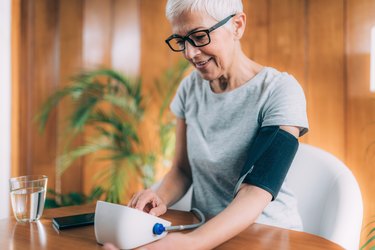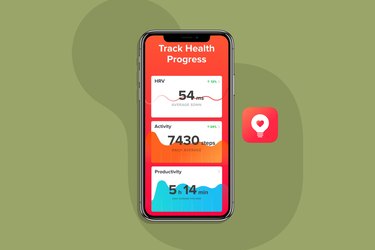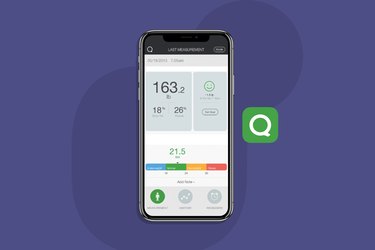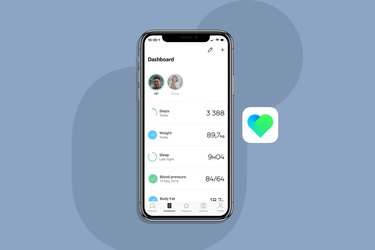
Blood pressure statistics show nearly half of U.S. adults have the condition, also called hypertension, according to the American Heart Association. Anyone living with this so-called silent killer should be monitoring their blood pressure regularly. But if you're not at the doctor's office, how exactly do you do that — and why does it matter?
We'll tackle the second question first: Monitoring is important to keep tabs on high blood pressure. If you take meds, or if you've made recent lifestyle changes, it can clue you and your doctor into whether those things are working. It may also alert you to patterns — like, for example, if stress or certain foods cause your numbers to spike.
Video of the Day
Video of the Day
That's why doctors recommend anyone with high blood pressure check their numbers at home — as much as two times a day if you're newly diagnosed, according to Harvard Health Publishing.
If your BP is well controlled, though, you may only need to check it once a day or less, Raj Kandwalla, MD, director of digital therapeutics at the Smidt Heart Institute at Cedars Sinai, tells LIVESTRONG.com.
Overall, Dr. Khandwalla says, the best blood pressure app for you is the one you'll use regularly. But here's a good place to start: These are five of the highest-rated and most reviewed apps for monitoring blood pressure and other cardiovascular statistics for iOS and Android devices.
1. Best Overall: Smart BP Smart Blood Pressure

This app allows you to record, track and analyze trends in blood pressure measurements. Numbers can be entered manually, or — when used on iOS devices — imported from a smart blood pressure monitor synced with Apple Health.
Reviewers love the ability to add notes and tags to their blood pressure measurements, noting when ("before dinner") and where ("left arm") each entry was taken. Data can be filtered by those tags, as well, which can help users notice patterns and determine whether any recent changes have affected their numbers.
Blood pressure information can also be exported and easily shared with doctors or family members using email or text messages. You can also set reminders for checking your BP regularly and can create multiple profiles so more than one person can use the same device.
Download for free from the App store or Google Play.
2. Best for Multitasking: Welltory: Heart Rate Monitor

Blood pressure is just one of the many metrics this app can track and analyze over time. It can also measure pulse rate and heart rate variability (just hold your finger over your device's camera), and offers dozens of self tests and assessments for conditions like anxiety, depression and burnout.
Welltory was designed to help users improve their health by keeping energy and stress levels in balance. According to company data, 82 percent of users report more energy and less stress in just 30 days.
While it's free to manually record your blood pressure in the app, you'll need to subscribe to the Pro version ($12.99 a month or $79.99 a year) to import measurements automatically from a smart blood pressure cuff, or to get analytics that can help you correlate lifestyle factors and stress with changes in your readings.
Download for free from the App store or Google Play.
3. Best for Integration: Qardio Heart Health

Purchase the $99 QardioArm smart blood pressure monitor — an easy-to-use, portable arm cuff — and pair it with this free app for automatic syncing and analytics. The app automatically takes the average of three consecutive readings (something doctors often recommend) and lets users set reminders and quickly share data with their health team.
Blood pressure measurements can be affected by stress levels, so it's important to feel relaxed when taking a reading from home. To help with that, Qardio Heart Health integrates with your device's photo library to offer a slideshow of enjoyable memories you can watch while you monitor.
Download for free from the App store or Google Play.
4. Best for Easy-to-Read Results: Blood Pressure Diary

This free Android-only app lets you track blood pressure and pulse measurements over time, with options to add notes and tags to each entry. It automatically categorizes readings into blood pressure zones, including stage 1 and 2 hypertension, prehypertension, normal and hypotension.
Data from this app can be exported into easy-to-read reports for health care professionals, and users can set up auto-backup to avoid losing important information. There's also an option to record heart rate, which can be helpful for people with certain cardiovascular conditions like arrhythmias.
Download for free from Google Play.
5. Best for Flexible Monitoring: Withings Health Mate

Withing's BMP Connect smart blood pressure monitor ($99.95) connects to this free app via wifi, which means that (unlike devices that sync via Bluetooth) your phone doesn't have to be right next to you during or after your measurement.
If you want an even more complete picture of your heart health from home, the app also works with Withing's higher-end BPM Core blood pressure monitor ($249.45), which includes a digital stethoscope and electrodes that can help detect valvular heart disease or abnormal heart rhythms.
Download for free from the App Store or Google Play.
How to Check Your Blood Pressure at Home
1. Get a Blood Pressure Cuff That Fits Well
So, how do you do it? You'll need a home blood pressure cuff, for starters. These devices can be purchased online or at a pharmacy, and there are many brands to choose from. (See LIVESTRONG.com's guide to the best blood pressure monitors to use at home.)
Two things to look for:
- Choose a cuff that's fit for the upper arm, Dr. Khandwalla says, because these provide the most accurate readings.
- Opt for a monitor certified by independent organizations like the British and Irish Hypertension Society or the Association for the Advancement of Medical Instrumentation.
Tip
Before you buy an at-home monitor, make sure the cuff is the right size by measuring the largest part of your upper arm. A too-small cuff can result in inaccurate readings.
2. Be Consistent
Try to always take your blood pressure at the same time every day, Dr. Khandwalla says. He recommends first thing in the morning, before you take any medication, and in the evening before you take medication, as well.
"Don't smoke or drink alcohol, and don't exercise or have any caffeinated beverages for 30 minutes beforehand," he says.
3. Take It Twice
Sit with your back straight and your feet flat on the floor, Dr. Khandwalla advises, and rest your arm on a table at chest level. It's also a good idea to take your blood pressure twice, separated by five minutes, and average those two readings.
4. Keep in Touch With Your Doctor
Remember that these apps are just one part of a complete heart-health strategy — and they shouldn't take the place of a doctor, especially not in an emergency situation.
"These apps can provide some interesting analysis and information, but ultimately the decision about how to manage your blood pressure should be between you and your primary care doctor or your cardiologist," Dr. Khandwalla says.
Ask your doctor if there's a specific app he or she recommends — there may be one that syncs up with their office's software, Dr. Khandwalla says. If not, you may be able to email or print files for your doctor right from the app.
- Harvard Health Publishing: "Checking blood pressure at home pays off"
- JMIR mHealth and uHealth: "Quality of Blood Pressure Tracking Apps for the iPhone: Content Analysis and Evaluation of Adherence With Home Blood Pressure Measurement Best Practices"
- BIHS: "For Home Use"
- American Heart Association: "Nearly half of U.S. adults could now be classified with high blood pressure, under new definitions
Is this an emergency? If you are experiencing serious medical symptoms, please see the National Library of Medicine’s list of signs you need emergency medical attention or call 911.